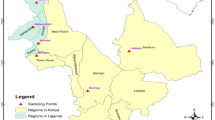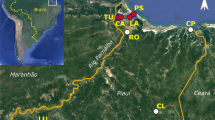Abstract
Genetic variation within and among six populations of Juniperus excelsa M. Bieb., in a common garden in Lakes District of Turkey, was analyzed using four nuclear microsatellite primer pairs originally developed for J. communis. A total of five loci were observed as Jc037 amplified two distinct size ranges. The number of alleles observed for the species varied from 2 to 13, with an average of 4.5 alleles per locus. The mean expected heterozygosity (H e) of populations was 0.584, after correction for null alleles. The mean F IS value (−0.014) was close to zero showing no significant deviation from Hardy–Weinberg equilibrium. A low level of genetic differentiation was observed among populations (F ST = 0.028; p < 0.001) and Nei’s genetic distance ranged from 0.014 to 0.120 between population pairs. Furthermore, there was no significant correlation between genetic distances on the one hand and geographic distances and trait differentiation on the other hand. However, the eastern populations Beyşehir and Sorgun showed very similar genotypic structures and were differentiated from all other populations. A continuous monitoring of phenotypic traits and the association between nucleotide variation in functional genes and adaptive traits such as drought and frost tolerance of J. excelsa populations in common gardens will be useful to design effective conservation strategies in the future.


Similar content being viewed by others
References
Adams RP (2008) Junipers of the world—the genus Juniperus, 2nd edn. Trafford, Vancouver
Anonymous (2006) Forest asset. Ministry of Environment and Forest. General Directorate of Forestry, Ankara, pp 55–57
Avşar MD, Tonguç F (2003) Evaluation of growth potential of crimean juniper (Juniperus excelsa Bieb.) seedlings for the first growing season under Tekir forest nursery conditions in Kahramanmaraş, Turkey. J Environ Biol 24:155–159
Baytop T (1999) Türkiye’de bitkilerle tedavi. Nobel Tıp Kitapevleri Pub, İstanbul
Castillo A, Dorado G, Feuillet C, Sourdille P, Hernandez P (2010) Genetic structure and ecogeographicaladaptation in wild barley (Hordeum chilense Roemer et Schultes) as revealed by microsatellite markers. BMC Plant Biol. 10:266. doi:10.1186/1471-2229-10-266
Chapuis MP, Estoup A (2007) Microsatellite null alleles and estimation of population differentiation. Mol Biol Evol 24:621–631
Çolak AH, Rotherham ID (2007) Classification of Turkish forests by altitudinal zones to improve silvicultural practice: a case-study of Turkish high mountain forests. Int For Rev 9:641–652
Doğmuş-Lehtijarvi HT, Lehtijarvi A, Aday AG (2008) European pear rust on Juniperus excelsa L. in south-western Turkey. For Path 39:35–42
Douaihy B, Vendramin GG, Boratyński A, Machon N, Bou Dagher-Kharrat MB (2011) High genetic diversity with moderate differentiation in Juniperus excelsa from Lebanon and the eastern Mediterranean region. AoB Plants. doi:10.1093/aobpla/plr003
Douaihy B, Sobierajska K, Jasińska AK, Boratyńska K, Ok T, Romo A, Machon A, Didukh Y, Bou Dagher-Kharrat M, Boratyński A (2012) Morphological versus molecular markers to describe variability in Juniperus excelsa subsp. excelsa (Cupressaceae). AoB Plants. doi:10.1093/aobpla/pls013
Ekué MRM, Gailing O, Finkeldey R (2009) Transferability of simple sequence repeat (SSR) markers developed in Litchi chinensis to Blighia sapida (Sapindaceae). Plant Mol Biol Rep 27:570–574
Eriksson G, Ekberg I (2006) An introduction to forest genetics. Swedish University of Agricultural Sciences, Uppsala
Evanno G, Regnaut S, Goudet J (2005) Detecting the number of clusters of individuals using the software STRUCTURE: a simulation study. Mol Ecol 14:2611–2620
Felsenstein J (1989) PHYLIP—phylogeny inference package (Ver. 3.2). Cladistics 5:164–166
Gülsoy AD, Gülsoy AM, Duman H, Kaya Z (2012) Molecular phylogeny of Juniperus species in Turkey based on noncoding trn region of cpDNA. In: International symposium on the biology of rare and endemic plant species (BIORARE, 2012), Mugla, 23–27 April 2012, p 39
Gültekin HC (2007) Türkiye Ardıç (Juniperus L.) türlerinin ekolojisi ve silvikültür teknikleri. TMMOB Forest Engineering Chamber Pub. Ankara
Guo S, Thompson E (1992) Performing the exact test of Hardy–Weinberg proportions for multiple alleles. Biometrics 48:361–372
Hall BH (1984) Juniperus excelsa in Africa: a biogeographical study of an Afromontane tree. J Biogeography 11:47–61
Hedrick PW (2000) Genetics of populations. Jones & Bartlett Publishers, Boston
Hojjati F, Zarre S, Assadi M (2009) Isoenzyme diversity and cryptic speciation in Juniperus excelsa (Cupressaceae) complex in Iran. Biochem Syst Ecol 37:193–200
Khajjak MH, Raza AM, Shawani MN, Ahmed F, Shaheen G, Saeed M (2012) Comparative analysis of essential oil contents of Juniperus excelsa (M. Beib.) found in Balochistan, Pakistan. Afr J Biotechnol 11:8154–8159
Korshikov II, Nikolaeva AV (2007) Genetic control of allozymes from the Juniper tall (Juniperus excelsa Bieb.) of Crimea. Cytol Genetics 41:209–212
Krutovsky KV, Neale DB (2005) Forest genomics and new molecular genetic approaches to measuring and conserving adaptive genetic diversity in forest trees. In: Geburek T, Turok J (eds) Conservation and management of forest genetic resources in Europe. Arbora Publishers, Zvolen, pp 369–390
Kumar P, Gupta VK, Misra AK, Modi DR, Pandey BK (2009) Potential of molecular markers in plant biotechnology. Plant Omics J 2:141–162
Langella O (2002) Populations (Version 1.2.28). Centre National de la Recherche Scientifique, France
Manly BFJ (2005) Multivariate statistical methods: a primer. Chapman and Hall/CRC Press, Florida
Marina D, Sokovic Ristic M, Grubisic D (2004) Chemical composition and antifungal activity of the essential oil from Juniperus excelsa cones. Pharm Biol 42:328–333
Michalczyk IM, Sebastiani F, Buonamici A, Cremer E, Mengel C, Ziegenhagen B, Vendramin GG (2006) Characterization of highly polymorphic nuclear microsatellite loci in Juniperus communis L. Mol Ecol Notes 6:346–348
Michalczyk IM, Opgenoorth L, Luecke Y, Huck S, Ziegenhagen B (2010) Genetic support for perglacial survival of Juniperus communis L. in Central Europe. Holocene 20:887–894
Neale DB, Kremer A (2011) Forest tree genomics: growing resources and applications. Nat Rev Genet 12:111–122
Nei M (1972) Genetic distance between populations. Am Nat 106:283–292
Nei M (1987) Molecular evolutionary genetics. Columbia University Press, New York
Nosil P, Funk DJ, Ortiz-Barrientos D (2009) Divergent selection and heterogeneous genomic divergence. Mol Ecol 18:375–402
NPNC (2007) National Biodiversity Strategy and Action Plan. Ministry of Environment and Forest, General Directorate of National Parks and Nature Conservation, Ankara, p 176
Nybom H (2004) Comparison of different nuclear DNA markers for estimating intraspecific genetic diversity in plants. Mol Ecol 13:1143–1155
Oostermeijer JGB, De Knegt B (2004) Genetic population structure of the windpollinated, dioecious shrub Juniperus communis in fragmented Dutch heathlands. Plant Species Biol 19:175–184
Öztürk M, Tümen I, Uğur A, Aydoğmuş-Öztürk F, Topcu G (2011) Evaluation of fruit extracts of six Turkish Juniperus species for their antioxidant, anticholinesterase and antimicrobial activities. J Sci Food Agric 91:867–876
Peakall R, Smouse P (2006) GENALEX 6: genetic analysis in excel. Population genetic software for teaching and research. Mol Ecol Notes 6:288–295
Pirani A, Moazzeni H, Mirinejad S, Naghibi F, Mosaddegh M (2011) Ethnobotany of Juniperus excelsa M. Bieb. (Cupressaceae) in Iran. Ethnobot Res Appl 9:335–341
Pritchard JK, Stephens M, Donnelly P (2000) Inference of population structure using multilocus genotype data. Genet Soc Am 155:945–959
Provan J, Beatty GE, Hunter AM, McDonald RA, McLaughlin E, Preston SJ, Wilson S (2008) Restricted gene flow in fragmented populations of a windpollinated tree. Conserv Genet 9:1521–1532
Ramanatha Rao V, Hodgkin T (2002) Genetic diversity and conservation and utilization of plant genetic resources. Plant Cell Tissue Organ Cult 68:1–19
Raymond M, Rousset F (1995) An exact test for population differentiation. Evolution 49:1280–1283
Santos T, Telleria JL, Virgos E (1999) Dispersal of Spanish juniper Juniperus thurifera by birds and mammals in a fragmented landscape. Ecogeography 22:193–204
Smouse PE, Long JC (1992) Matrix correlation analysis in anthropology and genetics. Yearb Anthropol 35:187–213
Uçar G, Balaban M (2002) The composition of volatile extractives from the wood of Juniperus excelsa, Juniperus foetidissima and Juniperus oxycedrus. Holz als Roh Werk 60:356–362
Unlu M, Vardar-Unlu G, Vural N, Dönmez E, Çakmak O (2008) Composition and antimicrobial activity of Juniperus excelsa essential oil. Chem Nat Compd 44:100–101
Van Der Merwe M, Winfield MO, Arnold GM, Parker JS (2000) Spatial and temporal aspects of the genetic structure of Juniperus communis populations. Mol Ecol 9:379–386
Vanden-Broeck A, Gruwez R, Cox K, Adriaenssens S, Michalczyk IM, Verheyen K (2011) Genetic structure and seed-mediated dispersal rates of an endangered shrub in a fragmented landscape: a case study for Juniperus communis in northwestern Europe. BMC Genet 12:73
Yaltırık F (1993) Dendroloji ders kitabı I. Gymnospermae (açık tohumlular). İÜ Forestry Faculty Pub, İstanbul
Yücedağ C, Gailing O (2012) Comparison of seven Juniperus excelsa M. Bieb. populations using multivariate methods (submitted)
Yücedağ C, Gezer A, Orhan H (2010) The genetic variation in crimean juniper populations from the Lakes District of Turkey. Rom Biotech Lett 15:5487–5492
Yücedağ C, Gezer A, Fakir H (2011) Variation of Fraxinus ornus subsp. cilicica (Lingelsh) Yalt in the Lakes District of Turkey. Sci Res Essays 6:4788–4791
Acknowledgments
The study was supported by the Council of Higher Education of Turkey under a post-doctoral fellowship to Dr. Cengiz Yücedağ at Michigan Technological University (MTU), Houghton, MI, USA. Funding for the study came from start-up funds of MTU to Oliver Gailing. We would like to express our thanks to Mr. Durmuş Yücedağ and Forest Engineer Suat Altınsoy for assistance in the field works.
Author information
Authors and Affiliations
Corresponding author
Additional information
Communicated by F. Canovas.
Rights and permissions
About this article
Cite this article
Yücedağ, C., Gailing, O. Genetic variation and differentiation in Juniperus excelsa M. Bieb. populations in Turkey. Trees 27, 547–554 (2013). https://doi.org/10.1007/s00468-012-0807-3
Received:
Revised:
Accepted:
Published:
Issue Date:
DOI: https://doi.org/10.1007/s00468-012-0807-3




